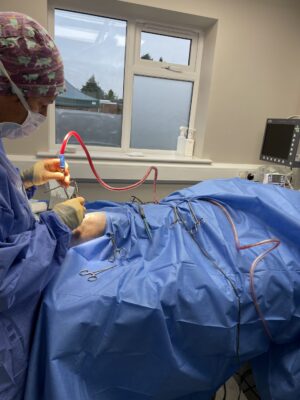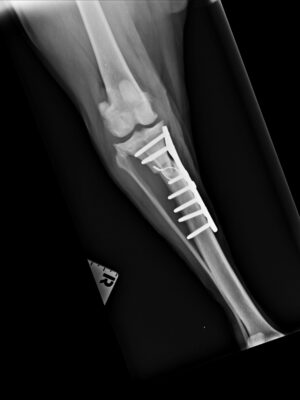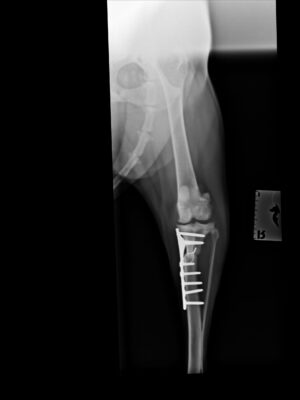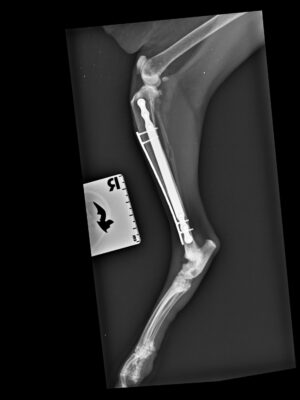Cruciate Ligament Repair
Cruciate Ligament disease or injury
The cruciate ligament is a small band of tissue that attaches the thigh bone (femur) to the shin bone (tibia) to help hold the knee joint stable. In dogs with cruciate injury, this ligament is damaged which creates excessive and painful movement of the knee joint.
This can be injured after a sudden trauma – similar to those injuries seen in footballers or skiers, where a sudden turn on the knee can cause ligament damage. More commonly however, dogs get a gradual degeneration and weakening of the ligament; similar to a rope fraying. The tear and degeneration usually happens because the angle of the femur against the tibia is sloped backwards, so when your pet puts weight on the leg the femur slips backwards and puts strain on and frays the ligament. Dogs can present with a mild intermittent hindlimb lameness, or a more sudden onset lameness, which can be quite marked.
This is more common in large breed dogs but can be seen in small dog breeds and cats too.
How can you diagnose it?
Clinical suspicion is based on examination of the joint. We may try manipulating the joint in certain ways to see if there is excessive motion of the joint. This is usually best performed under a sedation or anaesthetic but in some cases can be done consciously.
X-rays will be necessary for three reasons – firstly to examine the knee joint closer and rule out any other causes of lameness, secondly to confirm cruciate rupture and thirdly to help plan the size of the implants needed for surgery.
What is the treatment?
Surgical intervention is usually necessary to stabilise the joint to ensure the best short term and long term outcome. Unfortunately, cruciate rupture very rarely repairs on its own and if left untreated will lead to osteoarthritis in the future.
Non-surgical management:
Cruciate ruptures rarely heal on their own, but in some small dogs or cats or those patients where surgery or anaesthesia may not be possible, conservative management may be the best decision.
Management involves keeping an optimal body weight, physiotherapy, exercise modification and pain killers. We will initiate a restricted exercise program in the first instance with a gradual build-up, involving shorter controlled walks, and often hydrotherapy.
Surgical management:
For the best short-term and long-term resolution surgical repair is the best option. 90% of dogs will return back to normal activity.
We have an orthopaedic surgeon from ProVetSurg who visits Mulberry House Vets to carry out this advanced surgical procedure. This means there is no need to travel to a referral centre and your pet can be looked after in familiar surroundings by a team of vets and nurses who know them.
Surgery involves making cuts into the bone to change the angle of the joint so that it is stable when weight bearing. Metal implants hold the joint in place at this new angle while the bone heals.
We offer a fixed price fee for cruciate ligament repair surgery which includes all post operative checks, medications and 6 weeks post op xrays. Please see Our Prices page for these costs.
What to expect?
Dogs are usually starting to stand on the leg within 1-3 days after surgery, but full healing takes at least 6 weeks. Sutures are usually removed at 14 days, and a post-operative x-ray at 6 weeks will check that the bone has healed. The implants do not need to be removed.
It is important pets are rested and follow a strict exercise regime in the 6 weeks after surgery. Our surgeon will advise on this.
Physiotherapy can aid the recovery of the leg and we can put you in touch with a local physiotherapy company.
It is important to know that it is common for the other leg to become affected too.




Find Us
Opening Hours
- Monday - Friday8:30 - 18:30
- SaturdayClosed
- SundayClosed
- Bank HolidaysClosed
Opening Hours
- Monday - Friday8:30 - 18:30
- Saturday8:30 - 14:00
- SundayClosed
- Bank HolidaysClosed
Emergencies
If you have any concerns about your pet's health while we are closed, please call our our of hours emergency providers, Medivet 24 Hour Wokingham on:
01189 790 551
Book an
appointment
We know how busy life can be. Online appointment booking available 24/7.
Book appointmentEmergencies
If you have any concerns about your pet's health while we are closed, please call our our of hours emergency providers, MiNightVet on:
0118 973 3466


